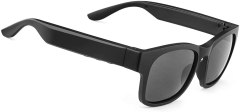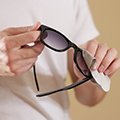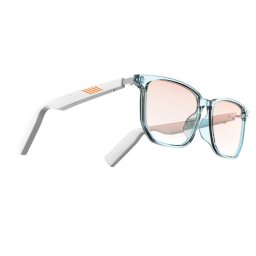Buying guide for best smart glasses
These days, having a smartphone means you have a camera and video recorder in your pocket at all times. Sometimes you might want a hands-free way to record the sights and sounds you’re taking in or listen to your favorite tunes during a workout. You need smart glasses.
Smart glasses are wearable computers that are able to record what you see while you’re wearing them. Many record audio, too, and all the information you capture is stored on a chip on the glasses. You can transfer the data via Bluetooth and WiFI to an app on your smartphone or another device. Some smart glasses also allow you to take phone calls, listen to music or other audio from your smartphone, or record images.
Key considerations
Type
You can choose from a few different types of smart glasses: video, audio, and combination.
Video: Some smart glasses offer only video capabilities. They feature a high-definition camera that allows you to take pictures and record videos while you’re wearing them. Some also allow you to watch videos. These glasses are great for travel because you can capture what you see while keeping your hands free.
Audio: Other smart glasses provide only audio capabilities, allowing you to listen to music and take phone calls. They’re ideal if you‘re only interested in listening to music or other audio while having your hands free as you work around the house, run, or hike.
Combination: You can also find combination smart glasses that offer both video and audio capabilities. You’re able to record videos, take pictures, listen to music, and take calls, so you get the best of both worlds. While you’ll pay a little more for these smart glasses, you don’t have to choose between video and audio functions.
Materials
Smart glasses come with frames made of a variety of materials. The most common options include the following:
Acetate frames are extremely durable, lightweight, and flexible. The most expensive smart glasses usually have acetate frames.
Nylon frames are extremely flexible and do well in temperature extremes, so they work well for people who are outdoor enthusiasts.
Plastic frames are very affordable and come in a wide array of colors.
Metal frames are generally the most durable, but they can be fairly heavy and pricey.
Battery
Like smartphones, smart glasses require power to operate. They have a built-in, rechargeable battery that allows you to record video or listen to audio without needing a connection. Some batteries offer a longer life than others, though. In general, you want to choose smart glasses with a battery life of at least 12 hours.
Pay attention to how easy the battery is to charge, too. Most smart glasses come with a USB cable for charging the battery.
Storage
Most smart glasses can store a certain amount of pictures and videos on them. You can find some pairs that hold as many as 3,000 photos and more than 100 videos. Others can only hold about 50 videos before you need to transfer the data to another device or cloud storage. You’ll typically pay more for smart glasses that offer more storage.
Caution
Smart glasses with video capabilities pose some privacy issues. You should always disclose when you’re taking photos or shooting videos with your glasses to make sure your subjects are comfortable.
STAFF
BestReviews
Features
Frames
Size: Just like traditional glasses, you want smart glasses in a size and style that flatter you. However, you may want to go a little larger with the frames on smart glasses because those with larger lenses typically provide a better view for taking photos and recording video.
Comfort: If you want smart glasses to wear on a long sightseeing trip or a grueling run, they should be as comfortable as possible. Lightweight frames are typically more comfortable than heavy ones. The frames should also have a smooth surface, so they don’t scratch or irritate your face and ears.
Lenses
Color: Most smart glasses have clear or transparent lenses. Some have tinted lenses and look similar to sunglasses. Tinted lenses can keep you from squinting in bright light, but if you plan to wear the glasses indoors, you may not want dark lenses. You can find some smart glasses with a slight tint, such as blue or amber, which offers some shield against glare from the light but isn’t as dark as sunglasses.
UV protection: Ultraviolet rays can damage your eyes as well as your skin. Some smart glasses have lenses that provide UV protection. This is especially important for glasses you plan to wear outdoors. For indoor use, you may want to find smart glasses that offer protection against the blue light generated by phone, computer, and TV screens.
Polarization: Polarized lenses can reduce glare to make it easier to see in bright sunlight. In addition to UV protection, you may want to choose smart glasses with polarized lenses if you plan to wear them mainly outdoors.
Extras
Water resistance: If you lead an active lifestyle and plan to wear your smart glasses in or around water, look for a water-resistant pair. They’re more expensive, so you really only need them if you plan to wear them around water.
Fitness tracking: In addition to recording video and providing audio functions, some smart glasses also provide fitness tracking capabilities. They usually track steps, distance covered, calories burned, and active minutes to help you achieve your fitness goals.
Expert Tip
Most smart glasses shouldn’t be submerged in water. Instead, dampen a cloth and wipe it over the glasses to clean them.
STAFF
BestReviews
Smart glasses prices
Smart glasses vary in price based on type, frame material, and other features. Most cost between $14 and $1,000.
Inexpensive: The most affordable smart glasses typically only have audio capabilities, though you can find some video-only glasses with less durable frames in this price range, too. These glasses generally cost between $14 and $70.
Mid-range: These smart glasses are usually higher-end audio-only or video-only pairs. They offer more durable frames and other features like water resistance or UV protection. You can also find some lower-end combination smart glasses in this price range. These glasses usually cost $70 to $350.
Expensive: The most expensive smart glasses are those with both audio and video capabilities. These offer durable frames and special features like UV protection, polarization, and water resistance. Some even allow you to watch videos through streaming services with built-in WiFi. You can expect to spend $350 to $1,000 for these glasses.
"Introduced in 2013, Google Glass was the first pair of consumer smart glasses available to the public."
STAFF
BestReviews
Tips
- Wear your smart glasses while doing chores. Smart glasses allow for hands-free operation, so you can wear them for many tasks around the house when you don’t want to fuss with a smartphone or tablet. Wear your glasses while gardening, mowing the lawn, washing dishes, or vacuuming, and you can get your work done while enjoying your favorite music.
- Wear your smart glasses while exercising. Smart glasses with audio are especially ideal for biking and running because you can listen to your favorite workout tunes but still hear the world around you. That makes them much safer than traditional headphones since you’ll be aware of traffic and other people who are nearby.
- Wear your smart glasses to a special event. Video smart glasses are ideal for recording special events like weddings, graduations, or parties because you can preserve memories with photos or video without having to fiddle with a smartphone or camera and miss any of the action.
FAQ
Q. How do you charge smart glasses?
A. It depends on the model. Some come with a charging case that you plug into a wall outlet or computer and place the glasses inside for charging. Other glasses only include a USB charging cable that you attach to the glasses and then plug into a wall adapter or USB port on your computer. Many people prefer glasses that come with a case because you don’t have to worry about the glasses getting damaged while they’re charging.
Q. What controls do smart glasses have?
A. Most have simple touch buttons on the frames that you use to control the functions. Other glasses respond to voice commands, so you don’t need to use your hands at all to operate the glasses.
Q. Can I wear smart glasses while I’m driving?
A. Even though smart glasses leave your hands free, wearing them while driving can be very distracting and dangerous. In fact, some jurisdictions have laws against driving with smart glasses because it’s believed they contribute to accidents.


























